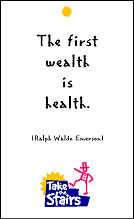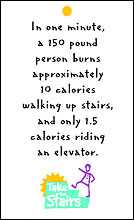Motivational Signs
The adage is true — old habits ARE hard to break. And for most people, riding the elevator is an old habit. Some people even forget that there are stairs! Posting motivational signs at the places where people have a choice between the stairs and elevator is an important aspect of encouraging people to use the stairs. However, messages and artwork that are motivating to one audience may be a turn-off to another, which is why it is important to test them with your audience first. Find out what motivates your audience and tailor your messages and artwork accordingly. This will help maximize the effectiveness of this intervention.
What We Did
Creating and Testing Signs
Below is a brief description of how CDC created and tested messages for its signs:
- A group of people with combined knowledge about physical activity as well health communication and social marketing brainstormed different kinds of messages to consider for the signs (inspirational, factual, and congratulatory). They focused on what they thought would be most motivational to employees.
- Two focus groups were conducted to see how well these messages tested with the audience (employees working in the Rhodes Building). One focus group was done with employees who frequently used the stairs. The other focus group was done with employees who were not frequent stair users.
- The moderator welcomed participants and refreshments were offered. The moderator reiterated that the purpose of the focus group was to obtain participants' candid responses regarding the messages that would be placed in various locations throughout the building promoting stairwell use. Participants were asked to speak openly and honestly about the messages.
- The moderator asked participants to introduce themselves, state on which floor their offices were located, and how their bodies reacted when they walked the stairs. These questions prepared participants for message testing.
- Next, participants were shown each pre-made sign highlighting a message, and were asked how they felt about the sign.
- The information gathered from the focus groups was then used to further tailor the messages to meet the needs and perceptions of the audience.
- After the signs were created, they were placed strategically at "points-of-decision" around the building. (e.g., sign at the elevator saying, "No waiting one door over.")
What You Can Do
- Develop some signs, or start with ours.
- Hold a focus group with some employees to get feedback about the signs. If possible, include employees who regularly use the stairs, and employees who don't.
- At the focus groups, explain the purpose of the project. Tell participants that their honest opinion is needed. Show examples of the signs and ask for their opinions. Do the signs make them feel motivated? Interested? Irritated? Use this feedback to develop signs that work for your employees.
If you don't have the time or money to invest in such thorough research, you can test your signs and artwork more informally. Ask colleagues around the office to tell you what they think of various signs, and artwork. Or send out a survey over email. Any input you get is going to help you make better decisions, increases awareness of the project, and makes people feel involved!
Message Ideas
Research indicates that signs are an effective motivator for behavior change involving point-of-prompt decisions, like choosing between the stairs or the elevator. Whether the messages are inspirational, factual, health-related, or humorous, find out what works best with your audience. Below is a list of sample messages. Feel free to use any of these on your signs, or create your own!



Remember to first test them with your audience!
Set 1
- Change happens one step at a time.
- I'm walkin'. Yes, indeed. (Fats Domino)
- The victory is not always to the swift, but to those who keep moving.
- Physical activity will add years to your life, and life to your years.
- The first wealth is health. (Ralph Waldo Emerson)
- In one minute, a 150 pound person burns approximately 10 calories wakling up stairs and only 1.5 calories riding an elevator.
- Walking up stairs burns almost 5 times more calories than riding an elevator.
- There are 1440 minutes in every day…schedule 30 of them for physical activity.
- No waiting one door over.
- Small steps make big differences.
- Raise your fitness level, one step at a time.
- Fight fat….Feel fit….Frequent these flights.
- Step up to a healthier lifestyle.
- Take a little walk with me. (Muddy Waters)
- One step farther each day. You can do it.
- Now that you have refueled...
Set 2
- Step up to a healthier and greener lifestyle.
- Burn calories. Stress less. Get healthy.
- Add years to your life and life to your years.
- Small steps make a big difference.
- There are 1440minutes in every day -- take 5 now.
- Go green in your daily routine.
- No waiting one door over nearest stairwell
- No waiting ne door over nearest stairwell
- Burn calories, not kilowatts.
- Raise your fitness level, one step at a time.
- Page last reviewed: September 4, 2015
- Page last updated: October 14, 2015
- Content source:



 ShareCompartir
ShareCompartir